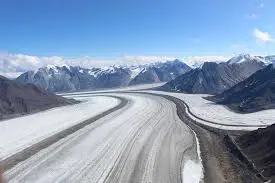A massive glacier collapse struck Switzerland’s Lötschental Valley. The alpine village of Blatten now lies in ruins. This disaster raises urgent questions about climate change in the Alps. On May 28, 2025, a huge section of the Birch Glacier broke apart. It triggered a landslide of ice, mud, and rock. About 90% of the village was buried. Early evacuations saved most lives. Yet, one person is still missing. The event has sparked debate over glacier risks. It also highlights threats to alpine communities. Let’s explore the collapse, its aftermath, and the causes.
The Collapse: A Sudden Disaster
At 15:30 on May 28, the Birch Glacier above Blatten gave way. Drone footage showed ice, rock, and debris rushing down the mountain. The village was engulfed in brownish sludge. The regional government estimates 3 million cubic meters of material fell. That’s about 106 million cubic feet. Some sources report 10 million tons of rubble. The collapse triggered a 3.1-magnitude earthquake on Switzerland’s scale.
Blatten is a small village in the Valais Canton. It had 300 residents. Geologists warned of an avalanche risk on May 19. So, the village was evacuated. This likely saved many lives. Still, the destruction is massive. Mayor Matthias Bellwald spoke at a press conference. He called it “the unimaginable.” He added, “We lost our village, but not our heart.” A 64-year-old man remains missing. Search efforts with drones continue despite risks.
Aftermath and Ongoing Dangers
The landslide buried homes, roads, and forests. A vast plain of mud now covers Blatten. The Lonza River was blocked by debris. This formed a lake. By Thursday morning, the lake flooded the village’s remaining buildings. Authorities raised the capacity of a downstream dam. They also evacuated nearby villages like Wiler. They fear the lake might overflow. Raphael Mayoraz leads the Natural Dangers Service for Valais. He said the debris could fill 1,200 Olympic-sized swimming pools. This poses a major flooding risk.
The Swiss Army is helping with rescue efforts. But the situation remains dangerous. On X, users express shock and grief. Some call it the “catastrophe of the century.” This follows another tragedy near Zermatt. Five skiers’ bodies were found on a glacier days ago. These events show the growing dangers in the Alps.
Is Climate Change to Blame?
Experts link the collapse to climate change. Switzerland has more glaciers than any European country. But they are shrinking fast. In 2023, the country lost 4% of its glacier volume. This was the second-worst year after a 6% drop in 2022. Matthias Huss leads Glacier Monitoring in Switzerland (GLAMOS). He said warming temperatures loosen rocks in the permafrost zone. This likely caused the collapse. Christophe Lambiel, a geologist at the University of Lausanne, agrees. He noted the glacier’s supporting rock face had weakened. This process worsened over the past 10–15 years.
Christian Huggel teaches at the University of Zurich. He called Blatten’s destruction unprecedented in recent Swiss history. Warming melts permafrost and destabilizes slopes, he explained. But some experts are cautious. They say climate change may not be the only cause. Mylène Jacquemart, a glaciologist at the Federal Institute of Technology Zurich, pointed out uncertainty. She said the glacier might have collapsed under the weight of rocks above it. More research is needed to confirm the exact trigger.
A Growing Pattern in the Alps
Blatten isn’t the first village to face such a disaster. In 2023, a rockslide nearly hit Brienz. Bondo faced a similar threat in recent years. Glaciologists have long warned about risks to alpine towns. Glaciers are retreating. Permafrost is thawing. This trend may worsen. The Paris Agreement aims to keep global warming below 1.5°C. If temperatures exceed this, risks will grow. The Swiss Broadcasting Corporation (SRF) predicts Switzerland’s glaciers could vanish in a century. This threatens a region where glaciers are both natural wonders and cultural symbols.
The Blatten disaster shows gaps in current strategies. Authorities evacuated the village in time. But the collapse was larger than expected. Some debris overflowed an avalanche protection dam. It stopped just 400 meters from nearby homes. Alban Brigger, a natural hazards engineer in Upper Valais, had warned about the mountain’s instability. Yet, the event’s speed and size surprised experts.
Rebuilding and Moving Forward
Blatten’s future is uncertain. Mayor Bellwald wants to rebuild. He has asked for national and international help. But the challenges are huge. The village’s infrastructure is mostly gone. More landslides and flooding could happen. Residents have lost their homes. The emotional and financial toll is heavy. One resident told Reuters, “I lost everything.”
This tragedy calls for better strategies in alpine regions. Evacuations saved lives. But long-term solutions are needed. Improved monitoring can help. So can stronger infrastructure. Global efforts to fight climate change are also key. The Blatten collapse reminds us of nature’s power. It shows the risks for communities near melting glaciers.
For the latest updates on this story, visit Bullish Stock Alerts.









0 Comments